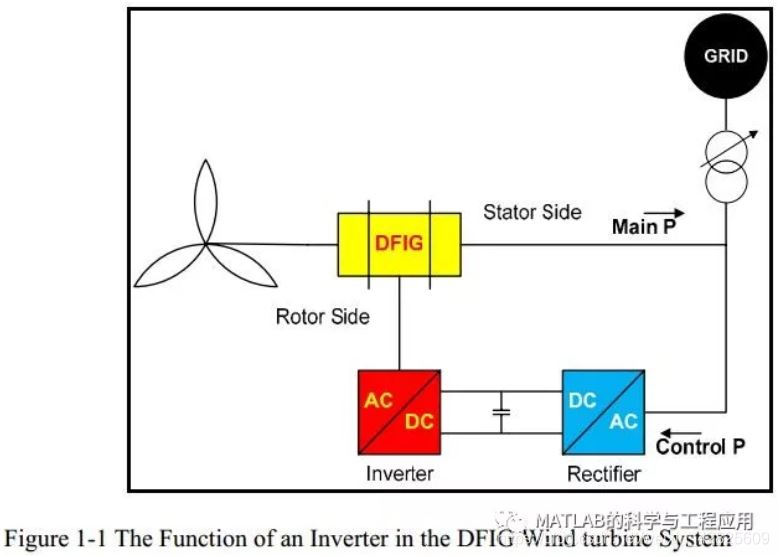【電力電子】【2009.12】基於TMS320F2812數字訊號處理器的三相逆變器設計與實現

本文為美國德克薩斯大學奧斯汀分校(作者:Duehee Lee)的碩士論文,共173頁。
本課題的目標是設計一個由TITMS320F2812 DSP控制的三相逆變器。通過控制TMS320F2812,使逆變器模擬產生來自計算機的主參考訊號的輸出波形。該專案包括在兩個平臺上構建三個不同的逆變器(包括輔助電路),併為逆變器設計五種脈寬調製(PWM)開關演算法。
本課題研究動機是需要新設計的逆變器作為計算機與實驗室級別風力渦輪機模型之間的中間裝置。這種型別的風力渦輪機用於教學和培養工程師,並提取風力發電的實驗資料。然而,由於商用逆變器不能夠接收從計算機發送的主參考訊號,以操作實驗室級別的風力渦輪機,因此需要設計可控、可變的逆變器來接收該訊號。
在VSI平臺上搭建了電壓源逆變器(VSI)和電流控制電壓源逆變器(CC-VSI),在CSI平臺上搭建了電流源逆變器(CSI)。此外,還設計了TMS320F2812的模擬數字轉換器(ADC)驅動電路和輸出LC濾波器作為輔助電路。編寫了5種PWM開關程式,3種開關程式用於VSI,一種用於CC-VSI,一種用於CSI。採集了上述軟硬體結合的輸出波形,能夠很好地跟蹤主參考訊號。雖然每個逆變器的效能良好,但是VSI結合空間向量PWM開關演算法能夠產生具有最小噪聲量的最乾淨的輸出電壓波形。
本文設計的逆變器可以應用於實驗室規模的風力渦輪機、太陽能電池板的最大功率跟蹤、分析數字訊號處理的裝置。然而,在這些應用中使用逆變器之前,要解決死區時間引起的訊號失真、固定開關頻率引起的諧波訊號以及安裝在麵包板上引起的可靠性問題等許多工作。綜上所述,雖然本文沒有詳細說明這三臺逆變器的整個過程,也沒有詳細說明每臺逆變器的構造要求,但提供了足夠的逆變器拓撲、硬體設計和PWM開關演算法等資訊,根據這些資訊完全可以重新復現三相逆變器的設計。
The goal of this thesis project was to design and build a three-phaseinverter controlled by the TMS320F2812DSP by Texas Instruments. The TMS320F2812is controlled in order to make inverters generate output waveforms which mimicthe main reference signal coming from a computer. The project included buildingthree different inverters on two platforms including auxiliary circuits anddesigning five pulse width modulation (PWM) switching algorithms for the inverters.The motivation was that a newly designed inverter was required as an intermediarydevice between a computer and a laboratory-scaled model of a wind turbine. Thistype of wind turbine is used to educate students and engineers and to extract experimentalwind power data. However, since commercial inverters don’t follow the mainreference signal which is sent from the computer in order to operate thelaboratoryscaled wind turbine, a controllable and variable inverter needed tobe designed to receive that signal. The results are as follows. The voltagesource inverter (VSI) and the currentcontrolled voltage source inverter(CC-VSI) were built on the VSI platform, and the current source inverter (CSI)was built on the CSI platform. Furthermore, the TMS320F2812’sanalog digital converter (ADC) driver circuit and the output LC filter werealso designed as auxiliary circuits. Five PWM switching programs were written; threeswitching algorithms for the VSI, and one algorithm each for the CC-VSI and theCSI. The output waveforms from the combination of hardware and softwarementioned above were captured, and they follow the main reference signal verywell. Although each of the inverters performed well, the VSI in combinationwith the Space Vector PWM switching algorithm produced the cleanest outputvoltage waveforms with the least amount of noise. The inverters built in thisthesis project can be applied to the laboratory-scaled wind turbine, themaximum power tracking in solar panels, and equipment for analyzing digitalsignal processing. However, before using the inverters in those applications,much work remains to be done to solve the problems related to the signaldistortion caused by the dead band time, harmonic signals caused by the fixedswitching frequency, and the reliability issues caused by mounting on the breadboard. In conclusion, although this thesis does not illustrate the entireprocess of or explain every requirement for building the three inverters,enough information about the topology of the inverters, the hardware design,and the PWM switching algorithms is provided in this thesis to enable one toremake all three of the three-phase inverters.
1 引言
2 逆變器理論
3 TMS320F2812的基本功能
4 TMS320F2812的具體實現
5 硬體設計與實現
6 結論與未來研究展望
下載英文原文地址:
http://page5.dfpan.com/fs/8lccdje2b2c182c9163/
更多精彩文章請關注微訊號:
